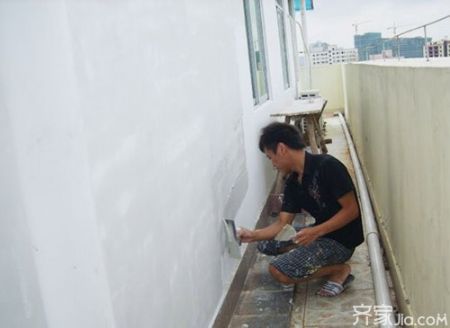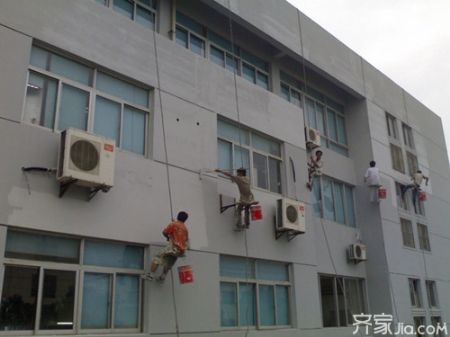Exterior wall waterproofing is a divisional waterproofing project that ensures the structure of buildings (structures) is not attacked by water and the interior space is not harmed by water. External wall waterproofing occupies an important position in the entire construction project. The following introduces the process and essentials of the external wall waterproof construction plan.

1. Base surface treatment
(1) The waterproof seal of the window frame and the wall joints is performed by using the sealant and the sealing material. Sealant and flexible waterproof material caulking material. The sealing material is highly resilient and crack resistant.
(2) The outer wall is reserved for waterproof sealing of expansion joints.
(3) Exterior wall holes and large cracks Before waterproofing and sealing, clean the outer wall surface, expansion joints, window frames and other parts to be treated with tools such as water spray guns, so that the external wall surfaces and seams, holes, and holes in the construction The parts reached no oil, dust, loose particles of cement and other debris. After it is dried, the holes, holes, and seams are filled and sealed with a waterproof sealing material, and the same color as the original color is achieved, and then the rapid plugging king and the transparent waterproof king are used for the meticulous construction.
(4) Hollow drums and cracks are grouted on the outer walls of large-scale ceramic tiles, and the construction is performed using inorganic water-stopping grouting material.
(5) The whole outer wall tile sealant waterproof seal, using high quality and efficient environment-friendly jointing materials.
(6) The overall strip-shaped tile wall is waterproof, and Nano Waterproof King is used for meticulous construction. The material has the advantages of excellent waterproof performance, good air permeability, convenient construction, safe use, reliable quality and good durability.

2, coating essentials
(1) Coated with a roller, brush, or sprayer, and completed layer by layer according to the order of the selected construction method.
(2) Precipitates in the paint should be stirred at any time, the coating should be as uniform as possible, and there should be no local deposition.
(3) The interval between layers is based on the previous layer of dry film and sticky hands.
(4) Before the second pass of the first pass of the coating is dry and firm, the quality of the roller brush or spray should be thoroughly checked, and the presence of missing paint and trachoma should be checked and promptly added.
3, enhancement layer and node processing
(1) The enhancement layer is mainly aimed at the weak link of the construction site, that is, the site that is likely to cause leakage. Strengthen the treatment to improve the waterproof safety performance and ensure the waterproof effect.
(2) In the parts to be reinforced, such as the internal corners and nozzles, a small arc of cement mortar should be used first, and the gaps and holes should be repaired to complete the gaps and holes and seal the window frame and wall. Joints, then transparent infiltration of the colorless nano-waterproof King spraying on both sides, cleaning the construction of the base layer, sealing the window frame and the wall joints, plugging the external wall faces, holes and larger gaps, re-doing the roof and exterior walls reserved Expansion joint waterproof layer, with a transparent and efficient anti-Wang brushing on the entire outer wall of all tile joints and then painted waterproof waterproof slurry Wang Wang 1 times.

4, paint brushing construction
(1) The brushing should begin from the lowest point on the plane starting from the furthest distance from the upper loading port. When the elevation and the plane need to be constructed, the rear plane should be erected.
(2) According to the quantity of one stirring and the thickness requirement of one painting, the construction surface is divided, and the material for each stirring is controlled to be used in this area to ensure the accuracy of the coating thickness.
(3) When the balconies, bay windows and other flats are applied by squeegeeing, the uniformly mixed paint shall be poured evenly on the base surface according to the amount, and it shall be evenly scraped with a brush. The scrapings on the plane shall be perpendicular to each other. When the facade is painted, the direction of the brush should be applied from bottom to top. Attention should be paid to the slurry flowing to the inside of the shade to prevent it from being cracked due to excessively thick deposits.
(4) After the initial dry solidification (2 to 4 hours apart), apply it again a second time. Judgment on preliminary dry solid standards: The walls have been dry to the touch. Spray two or three times in sequence.
(5) Do not incorporate moisture or other materials into the product during use. Use appropriate protective measures, such as gloves, during construction.
(6) Rain, snow and windy days are not allowed to construct. Foggy days are required to be dried after the dew has dried. If there is rain during construction, measures should be taken to prevent rain.
(7) The overall review, if it is found leaking, leaking coating at a timely manner. During the construction or 24 hours after the construction, no water shall be poured. In this way, the waterproof layer made according to the standard can be used for 20 years under sunlight exposure.
(8) Spray water test and acceptance.
Editor's summary: About the external wall waterproofing construction program flow and essentials are introduced here, and hope to be helpful to everyone.